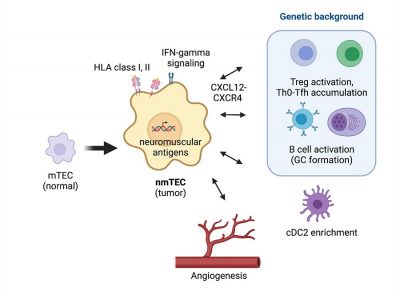Yoshiaki Yasumizu, Tatsusada Okuno, Hideki Mochizuki ≪Neurology≫, Naganari Ohkura≪Frontier Research in Tumor Immunology≫, Yasushi Shintani ≪General Thoracic Surgery≫, Eiichi Morii ≪Histopathology≫ Finding a way to defend a self-attack
Publish Nature Communications
Researchers from Osaka University identify the specific cells that contribute to the pathology of myasthenia gravis combined with thymus tumor

Figure 1. Proposed MG pathology in thymoma
Autoimmune diseases occur when a person’s antibodies mistakenly recognize their body’s own cells as foreign invaders and attack them. One such disease is myasthenia gravis (MG), where the antibodies target neuromuscular-associated proteins. MG is common in patients with thymoma, a type of tumor of the thymus, but reasons for this are unclear. Recently, Osaka University researchers used genetic techniques to examine the relationship between these two diseases. Their findings may pave the way for new treatments for this condition.
In a recent article published in Nature Communications, the team described how they aimed to identify thymoma-specific changes that occur in cells of the thymus – part of the lymphatic system – to find the connection with MG. A variety of epithelial cells within the thymus work together during various steps of T cell maturation. T cells are key fighters of the human immune system. One step is mediated by medullary thymic epithelial cells (mTECs), which help prevent the production of self-targeting T cells. Previous studies have shown that immune cells involved in producing antibodies are enriched in MG-thymoma cases, but their role in the effects of MG are not well understood.
“At a very basic level, many diseases are ultimately fueled by abnormal gene expression patterns,” says lead author Yoshiaki Yasumizu. “We believed that examining the levels of certain RNA molecules in MG-thymoma samples would help us find specific genes directly involved in this disease.”
Using a method called RNA-sequencing, the team evaluated over 100 thymoma samples and looked for genes that differed in expression levels between cases with and without MG. These experiments helped them identify neuromuscular molecules that were present in higher amounts in MG-thymoma samples.
“Further work showed us that these neuromuscular molecules are expressed in a subpopulation of mTECs, which led us to name them neuromuscular mTECs (nmTECs),” explains Hideki Mochizuki, senior author of the study.
Molecular characterization of the nmTECs suggested that they are capable of a process called antigen presentation, where a molecule is placed at the cell surface to induce an immune response against it. The nmTECs present the neuromuscular molecules, leading to the production of antibodies against them.
“We also observed abnormal follicular structures and T/B cell behaviors, all of which help produce a microenvironment that can support autoimmune outcomes,” says Yasumizu.
By staining certain proteins using a technique called immunohistochemistry, the team was able to confirm the presence and enrichment of nmTECs in MG-thymoma samples. Overall, this study provides strong evidence that nmTECs are significantly involved in MG through high expression of neuromuscular molecules. This new knowledge may be the key for the development of novel therapeutic methods for this disease combination.
###
The article, “Myasthenia gravis-specific aberrant neuromuscular gene expression by medullary thymic epithelial cells in thymoma,” was published in Nature Communications at DOI: https://doi.org/10.1038/s41467-022-31951-8
Summary: Osaka University researchers identified a specific subpopulation of cells in the thymus that are significantly involved in cases of thymus tumor called thymoma in patients that also have an autoimmune disease called myasthenia gravis. These thymic epithelial cells express high levels of certain neuromuscular molecules that, together with some immune cell abnormalities, cause the body to attack its own cells. The molecular details uncovered in this study may be the key for novel therapeutic development.
Tweet 1: A new study from Japan uncovers crucial molecular details of a debilitating disease that combines an autoimmune disorder with thymus tumor
Tweet 2: Japanese researchers identify the specific molecules that cause the immune system of patients with a certain form of myasthenia gravis to attack its own cells
Primary Keyword: Health and medicine
Additional Keywords: Immune disorders, Autoimmune disorders, Myasthenia gravis, Thymus, Autoimmunity, Tumor cells, Autoantibodies
Method of Research: Experimental study
Subject of Research: Human tissue samples
Title: “Myasthenia gravis-specific aberrant neuromuscular gene expression by medullary thymic epithelial cells in thymoma”
Journal: Nature Communications
Authors: Yoshiaki Yasumizu, Naganari Ohkura, Hisashi Murata, Makoto Kinoshita, Soichiro Funaki, Satoshi Nojima, Kansuke Kido, Masaharu Kohara, Daisuke Motooka, Daisuke Okuzaki, Shuji Suganami, Eriko Takeuchi, Yamami Nakamura, Yusuke Takeshima, Masaya Arai, Satoru Tada, Meinoshin Okumura, Eiichi Morii, Yasushi Shintani, Shimon Sakaguchi, Tatsusada Okuno, Hideki Mochizuki
DOI: 10.1038/s41467-022-31951-8
Funded by: Japan Society for the Promotion of Science, Japan Agency for Medical Research and Development








